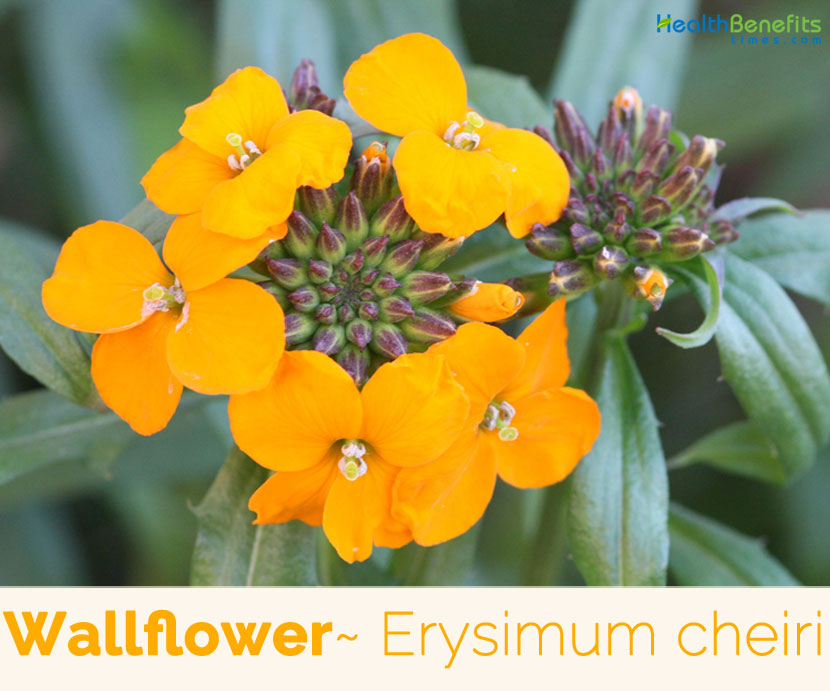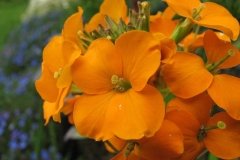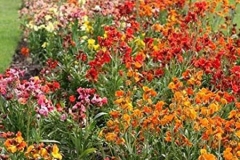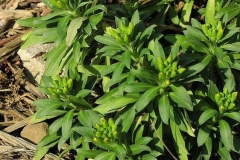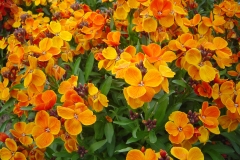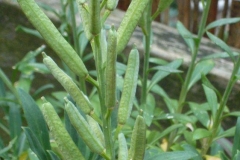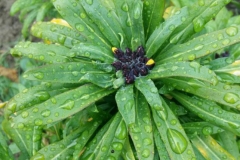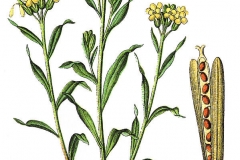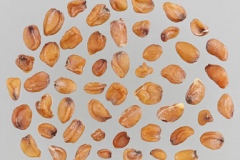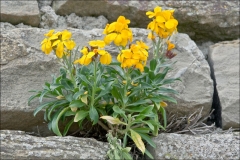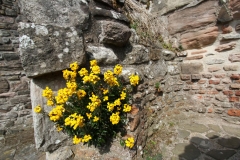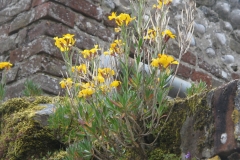Apart from that it’s interesting that this plant is still sold under their old name of “Cheiranthus” as well. The name Cheiranthus comes from the Greek words “cheir”, which means “hand” and “anthos” meaning “flower”, referring to a medieval custom in which the flowers were often carried in the hand at festivals. The species were formerly classified into two genera, Erysimum and Cheiranthus, but are now classed under the genus Erysimum.
Wallflower Facts
| Wallflower Quick Facts | |
|---|---|
| Name: | Wallflower |
| Scientific Name: | Erysimum cheiri OR Cheiranthus cheiri |
| Origin | Europe, especially Mediterranean region |
| Shapes | Long, narrow, hairy and slender siliques or pods about 40-75 mm long and 2.5-5 mm wide |
| Taste | Bitter |
| Health benefits | Good for dry bronchitis, fevers and injuries to the eyes, impotence, paralysis, aphthous, inflammations, menstruation, purify the kidneys and liver |
| Name | Wallflower |
|---|---|
| Scientific Name | Erysimum cheiri OR Cheiranthus cheiri |
| Native | Europe, especially Mediterranean region and is extensively cultivated around the world |
| Common Names | Wallflower, Aegean wallflower, Common Wallflower, gele muurbloem, Handflower, Perennial Wallflower, Blister Cress, Hedge Mustard, Cheir’s wallflower |
| Name in Other Languages | Afrikaans: Muurblommetjie Albanian: Femër e injoruar, lulja e Misirit, shebojë Arabic: Zahrat aljidar (زهرة الجدار) Armenian: Shahprak (շահպրակ) Azerbaijani: Xeyri Basque: Wallflower Belarusian: Zheltofiol’ sadovaya (желтофиоль садовая) Bengali: Wallflower Bosnian: Seboj Bulgarian: Mnogogodishen shiboĭ (многогодишен шибой) Catalan: Violer, violer groc Cebuano: Wallflower Chichewa: Kungokhala maluwa a pakhoma Chinese: Júwàirén (局外人) Croatian: Seboj Czech: Cekanka, chejr vonný, trýzel chejr, Cheirant voňavý Danish: Bænkevarmer, gyldenlak Dutch: Muurbloem, gyldenlak, gele muurbloem, English: Wallflower, Aegean wallflower, Common Wallflower, gele muurbloem, Handflower, Cheir’s wallflower, Common wallflower Esperanto: Levkojo Estonian: Kuldlakk Filipino: Mahiyaing tao sa pista Finnish: Seinäkoriste, Kultalakka French: Giroflée, Giroflée des murailles, Violier jaune, revenelle, velard, carafe, giroflée jaune, giroflée violier, violier Galician: Goivo-amarelo Georgian: Wallflower German: Mauerblümchen, Goldlack, gold lack, Echter Goldlack, Goldlack-Schöterich, Greek: mi chorévon theatís choroú (μη χορεύων θεατής χορού), Kitrini violetta Gujarati: Vōlaphlāvara (વોલફ્લાવર) Haitian: Creole jirofle Hausa: Filawan bango Hebrew: כָּתלִית Hindi: Wallflower Hmong: Wallflower Hungarian: Sárgaviola Icelandic: Veggblóm Igbo: Wallflower Indonesian: Gadis yg duduk tanpa berdansa Irish: Wallflower Italian: Violacciocca, leucojo giallo, barco, leucoio, viola gialla, violaciocca gialla Japanese: Nioi-araseitō, U~ōmufurawā (ウォームフラワー) Javanese: Wallflower Kannada: Phlavar (ಫ್ಲವರ್) Kazakh: Jeltofïol Baq (желтофиоль Бақ) Khmer: Wallflower Korean: Kkochmu (꽃무) Lao: Wallflower Latin: Wallflower Latvian: Goldlaks Lithuanian: Smalka Macedonian: Wallflower Malagasy: Wallflower Malay: Wallflower Malayalam: Vallphleāver ( വല്ല്ഫ്ലൊവെര്) Maltese: Wallflower, Ġiżi safra Maori: Wallflower Marathi: Wallflower Mongolian: Wallflower Myanmar (Burmese): Wallflower Nepali: Wallflower Netherland: Gele Muurbloem Norwegian: Veggpryd, lakkfiol, Gyllenlakk Occitan: Viòulié jaune Persian: شب بوی زرد Polish: Lak, lak pospolity Portuguese: Wallflower, goiveiro, goiveiro-amarelo, goivo-amarelo Romanian: Wallflower, micşunea, micșunele ruginite Russian: Zheltofiol’ sadovaya (желтофиоль садовая), Zheltofiol (Желтофиоль), Zheltushnik Cheri (Желтушник Чери), Lakfiol (Лакфиоль), lakfiol’ obyknovennyy (лакфиоль обыкновенный) Serbian: Sheboj (шебој), baštenski šeboj (баштенски шебој), žuti šeboj (жути шебој) Sesotho: Wallflower Sinhala: Wallflower Slovak: Cakanka, cheir voňavý, horčičník Slovenian: Wallflower, zlatenec, zlati šebenik Somali: Wallflower Spanish: Alhelí, Alhelí amarillo, Alhelí pajizo Swahili: Wallflower Swedish: Panelhöna, gyllenlack, Lackviol Tajik: Wallflower Tamil: Vāl ḥpiḷavar (வால் ஃபிளவர்) Telugu: Vālphlavar (వాల్ఫ్లవర్) Thai: Phụ̄ch yurop chnid h̄nụ̀ng (พืชยุโรปชนิดหนึ่ง) Turkish: Sarı şebboy Ukrainian: Zheltofiol’ sadovi (желтофіоль садові), lakfiolʹ zvychayna (лакфіоль звичайна) Urdu: Wallflower Uzbek: Wallflower Vietnamese: Vải hoa Welsh: Stad oddefol hon Yiddish: Vallflover (וואַללפלאָווער) Yoruba: Wallflower Zulu: Wallflower |
| Plant Growth Habit | Erect, woody-based, evergreen, herbaceous perennial herb, often grown as a biennial |
| Growing Climates | Walls, cliffs, old walls and rocks, often near the sea |
| Soil | It has a preference for light or sandy, medium/ loamy and heavy or clay soils. While it needs a properly drained soil, the plant can also grow in soils containing less nutritional substances |
| Plant Size | Grows 12 to 18 inches tall and 12 inches wide |
| Root | Woody taproot |
| Stem | Erect, woody, leafy, simple or usually much branched from the base, tomentose with stellate branched forked trichomes |
| Leaf | Basal leaves are simple, in dense rosulate, linear oblanceolate-oblong, about 40-90 mm long and 4-10 mm wide, base attenuate, margin entire or slightly dentate, apex acute, petiole very short to sub sessile |
| Flowering season | April to June |
| Flower | Flower has purplish-green sepals and rounded petals which are two to three centimeters long and in shades of bright yellows to reds and purples |
| Fruit Shape & Size | Long, narrow, hairy and slender siliques or pods about 40-75 mm long and 2.5-5 mm wide |
| Propagation | By seeds and through cuttings |
| Plant Parts Used | Flowers, stems, leaves, seeds |
| Seed | Sub-orbicular, pale brown and about 3 mm long |
| Taste | Bitter |
Plant Description
Wallflower is an erect, woody-based, evergreen, herbaceous perennial herb, often grown as a biennial that normally grows about 12 to 18 inches tall and 12 inches wide. The plant is found growing in walls, cliffs, old walls and rocks often near the sea. It has a preference for light or sandy, medium/ loamy and heavy or clay soils. While it needs a suitably drained soil, the plant can also grow in soils containing less nutritional substances. This plant loves sharp soil drainage as represented by its ability to grow in little pockets of gritty soil on stone walls as suggested by its common name of wallflower. The plant has woody taproot. Stem is erect, woody, leafy, and simple or usually much branched from the base, tomentose with stellate branched forked trichomes.
Leaves
Basal leaves are simple, in dense rosulate, linear oblanceolate-oblong, about 40-90mm long and 4-10 mm wide, base attenuate, margin entire or slightly dentate, apex acute, petiole very short to sub sessile. Cauline leaves are similar to base leaves becoming smaller towards the shoot, densely placed, petiole sub sessile to sessile.
Flowers
Flowers are bisexual, yellow, showy orange, about 2-2.5 cm across, pedicel erect, stout, ascending, about 5-8 mm long, up to 15 mm long in fruit. Sepals 4, sub equal, erect, oblong, apex obtuse, about 8-10 mm long. Petals 4, obovate-spathulate, base cuneate, margin entire, apex obtuse or sub emarginate, about 18-22 mm long and 10-14 mm across, claw broad differentiated. Stamens 6, tetradynamous, about 9-14 mm long, filaments simple, anthers linear-oblong, about 3-4 mm long. Ovary is superior, linear, ellipsoid-cylindrical, sessile, bicarpellary, syncarpous, pubescent. Flowering normally takes place in between April to June.
Wallflowers come in pale blues, greens, pinks, and creamy yellows, but you can also find them in warmer reds, oranges, hot pinks, and golden yellows.
Fruits
Similar to other plants belonging to the class of mustards, fertile flowers of these plant are followed by long, narrow, hairy and slender siliques or pods which has separate ribs and numerous seeds are arranged in one row. They are linear-sub cylindrical, compressed, terete, quadrangular, slightly curved, latiseptate, about 40-75 mm long and 2.5-5 mm wide. Seeds are light brown, oblong-ovoid, winged; about 3 mm long, minutely reticulate, mucilaginous when soaked.
Popular Varieties of Wall Flowers
- English Wall Flower: The English Wallflower (Cheiranthus kewensis), may be primrose, dark red, yellow, orange or purplish. It has brownish-orange flowers that turn purplish. In Europe the English Wallflowers are a common sight in the spring flowerbeds.
- The Siberian Wallflower: Cheiranthus Allionii, may be orange or yellow and are produced abundantly in April and May. Botanists consider it as a product of Erysimum asperum, a Native American species, which is hardier than the English variety.
- The Alpine Wall flowers: The Alpine Wall flowers may be yellow, orange-yellow, or purplish. Another Alpine variety, Cheiranthus linifolius, bears tiny, lilac-mauve flowers used in the rock garden. This plant is correctly named Erysimum linifolium.
Traditional uses and benefits of Wallflower
- In homoeopathic medicine a tincture of the whole plant has been found useful in the effects of cutting the wisdom tooth.
- Wallflower was previously used mainly as a diuretic and emmenogogue but recent research has shown that it is more valuable for its effect on the heart.
- In small doses it is a cardio tonic, supporting a failing heart in a similar manner to foxglove.
- Flowers and stems are anti-rheumatic, antispasmodic, cardio-tonic, emmenogogue, nervine, purgative and resolvent.
- They are used in the treatment of impotence and paralysis.
- The essential oil is normally used.
- Seeds are aphrodisiac, diuretic, expectorant, stomachic and tonic.
- They are used in the treatment of dry bronchitis, fevers and injuries to the eyes.
- Topical dilute decoction of the flower was recognized as a good remedy for aphthous and inflammations.
- Topical oil of flower has been stated as analgesic, anti-inflammation and hair tonic.
- Root in a topical decoction or poultice has been reported as analgesic and anti-inflammatory agent.
- Seeds in the form of sitz bath or vaginal suppository have been administered as emmenogogue, abortifacient and labor inducer.
- In Indian markets there is a multi-component tablet containing wallflower for breastfeeding mothers to improve lactation.
- In traditional societies of present India, wallflower is still used as an abortifacient agent.
- In Indian medicine, flowers are recommended as cardio active, antispasmodic, purgative, emmenogogue, deobstruent and tonic.
- Wallflower seeds are known as stomachic, diuretic, expectorant, but goitrogenic and the extracts of leaves and the seeds are antibacterial.
- Doctors prescribed wallflower to ease pain during childbirth, stimulate menstruation, purify the kidneys and liver as well as resolve cataract problems.
- Medications prepared with these parts of the wallflower are used to treat impotence and palsy/ paralysis.
- Seeds of the herb are often used to treat fever, dry bronchitis and even eye injuries.
Other Facts
- Flowers contain 0.06% essential oil.
- It has a pleasing aroma if diluted and is used in perfumery.
- Flowers of this plant are expansively used for bedding and are also useful as cut flowers and for containers.
- In Palestine, the wallflower is known as the ‘blood drops of Christ’.
- Dreaming of wallflowers is said to be a sign to those in love that their sweetheart will be true to them.
- Wallflowers grow only leaves in the first season from seed. Then in second season, blooms, seeds and dies with first frost.
- Erysimum is a symbol of fidelity.
Precautions
- The plant is said to be poisonous if used in large quantities.
- When taken in large doses, it is toxic.
- Use only under professional supervision.
- Do not take Wallflower during pregnancy.
References:
https://en.wikipedia.org/wiki/Erysimum_cheiri
http://www.missouribotanicalgarden.org/PlantFinder/PlantFinderDetails.aspx?taxonid=278066
http://www.floracatalana.net/cheiranthus-cheiri-l-
https://www.botanical.com/botanical/mgmh/w/wallfl04.html
https://plants.usda.gov/core/profile?symbol=ERCH10
https://www.itis.gov/servlet/SingleRpt/SingleRpt?search_topic=TSN&search_value=22936#null
https://npgsweb.ars-grin.gov/gringlobal/taxonomydetail.aspx?id=318992
https://www.cabi.org/isc/datasheet/13316
https://www.wikidata.org/wiki/Q159370
http://www.theplantlist.org/tpl1.1/record/kew-2799915
https://pfaf.org/user/Plant.aspx?LatinName=Cheiranthus+cheiri
https://www.flowersofindia.net/catalog/slides/English%20Wallflower.html
https://gd.eppo.int/taxon/CHUCH
https://davesgarden.com/guides/pf/go/1562/#b
https://indiabiodiversity.org/species/show/229653


